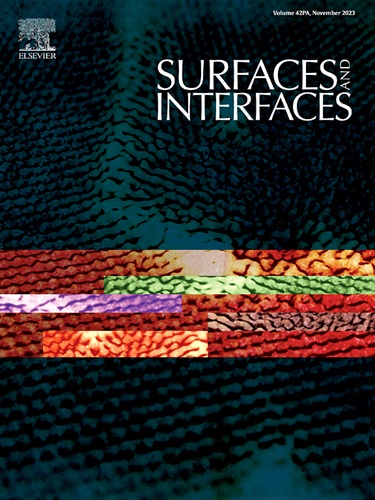形貌对铁催化剂理化性质及费托合成性能的影响
IF 5.7
2区 材料科学
Q2 CHEMISTRY, PHYSICAL
引用次数: 0
摘要
铁基费托合成催化剂的研究引起了人们的广泛关注。不同形态的Fe通常暴露出不同的晶面,影响FTS中的还原、渗碳和反应行为。在本研究中,制备了六种不同形态的Fe2O3催化剂,包括纺锤形、球形、长六方柱形、立方体、短六方柱形和花状。采用XRD、SEM、TEM、原位XRD、H2- tpr、H2- tpd、CO- tpd和DFT等表征技术,研究了形貌对相结构转变、还原行为、H2和CO吸附以及FTS性能的影响。结果表明,六种催化剂形貌规则,晶格条纹清晰,结晶度高。纺锤形催化剂更容易还原,对CO和H2的吸附效果更好,而立方催化剂更难还原,对CO和H2的吸附效果更弱。DFT实验表明,CO在纺锤形催化剂的(125)晶面上容易解离形成CO* (-0.77 eV),而在立方体催化剂的(024)晶面上容易解离成C*和O* (1.65 eV)。纺锤形催化剂的催化活性为95.35%,立方催化剂的催化活性为20.29%,FTS催化性能与表征一致。本文章由计算机程序翻译,如有差异,请以英文原文为准。

The influence of morphologies on the physicochemical properties and Fischer-Tropsch synthesis performance of iron catalysts
Research on Fe-based catalysts for Fischer–Tropsch synthesis (FTS) has attracted significant attention. Various morphologies of Fe usually expose different crystal planes, affecting the reduction, carburization, and reaction behaviors in FTS. In this study, six different morphologies of Fe2O3 catalysts, which include spindle, spheres, long-hexagonal columns, cubes, short-hexagonal columns, and flower-like were prepared. The impact of morphology on phase structural transformations, reduction behaviors, H2 and CO adsorption, and FTS performance was investigated using a suite of characterization techniques, including XRD, SEM, TEM, in situ XRD, H2-TPR, H2-TPD, CO-TPD, and DFT. The results indicate that the six catalysts have regular morphologies, clear lattice fringes, and high crystallinity. The spindle catalyst is more easily reduced and exhibits better adsorption for CO and H2, while the cubic catalyst is more difficult to reduce and shows weaker adsorption for CO and H2. DFT experiments suggest that CO readily dissociates on the (125) crystal plane of the spindle catalyst to form CO* (-0.77 eV), whereas on the (024) crystal plane of the cube catalyst, it dissociates into C* and O* (1.65 eV). The FTS catalytic performance is consistent with the characterization, with the spindle-shaped catalyst showing an activity of 95.35 %, and an activity of 20.29 % on cubic catalyst.
求助全文
通过发布文献求助,成功后即可免费获取论文全文。
去求助
来源期刊

Surfaces and Interfaces
Chemistry-General Chemistry
CiteScore
8.50
自引率
6.50%
发文量
753
审稿时长
35 days
期刊介绍:
The aim of the journal is to provide a respectful outlet for ''sound science'' papers in all research areas on surfaces and interfaces. We define sound science papers as papers that describe new and well-executed research, but that do not necessarily provide brand new insights or are merely a description of research results.
Surfaces and Interfaces publishes research papers in all fields of surface science which may not always find the right home on first submission to our Elsevier sister journals (Applied Surface, Surface and Coatings Technology, Thin Solid Films)
 求助内容:
求助内容: 应助结果提醒方式:
应助结果提醒方式:


